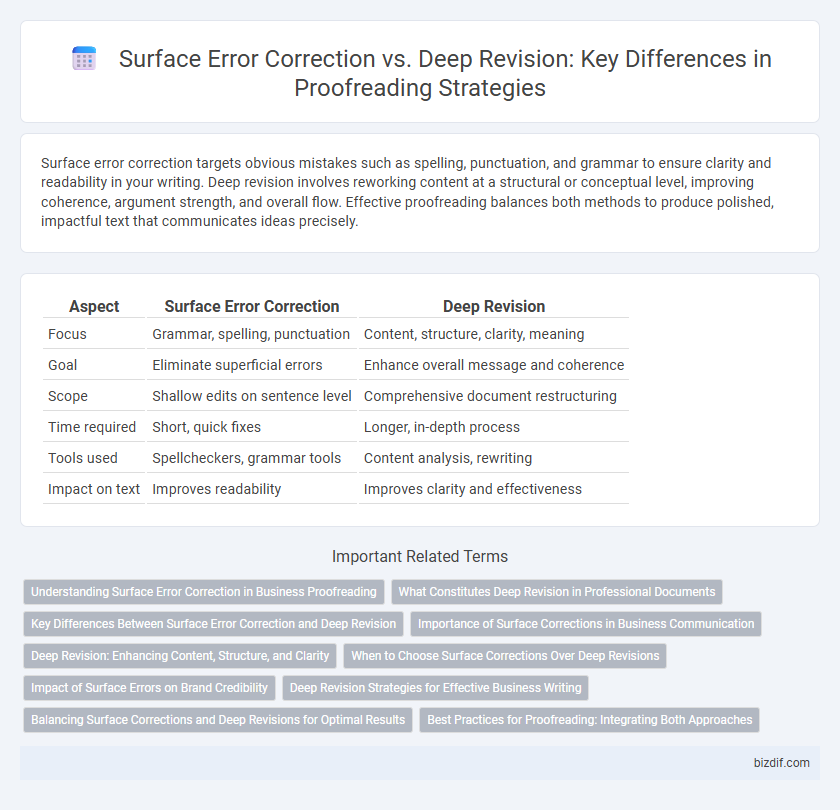Surface error correction targets obvious mistakes such as spelling, punctuation, and grammar to ensure clarity and readability in your writing. Deep revision involves reworking content at a structural or conceptual level, improving coherence, argument strength, and overall flow. Effective proofreading balances both methods to produce polished, impactful text that communicates ideas precisely.
Table of Comparison
| Aspect | Surface Error Correction | Deep Revision |
|---|---|---|
| Focus | Grammar, spelling, punctuation | Content, structure, clarity, meaning |
| Goal | Eliminate superficial errors | Enhance overall message and coherence |
| Scope | Shallow edits on sentence level | Comprehensive document restructuring |
| Time required | Short, quick fixes | Longer, in-depth process |
| Tools used | Spellcheckers, grammar tools | Content analysis, rewriting |
| Impact on text | Improves readability | Improves clarity and effectiveness |
Understanding Surface Error Correction in Business Proofreading
Surface error correction in business proofreading targets superficial mistakes such as spelling, punctuation, and grammar, ensuring the text adheres to professional standards without altering the original meaning. This level of proofreading enhances clarity and prevents misunderstandings in critical corporate communications, maintaining the document's integrity. Businesses rely on precise surface error correction to uphold brand credibility and avoid costly misinterpretations.
What Constitutes Deep Revision in Professional Documents
Deep revision in professional documents involves thorough restructuring of content to enhance clarity, coherence, and logical flow, addressing fundamental issues beyond mere surface error correction like grammar and spelling. It requires re-evaluating the document's purpose, audience, and key messages to ensure alignment with communication goals and incorporating substantive changes such as reordering sections or refining arguments. This level of revision significantly improves the overall effectiveness and professionalism of documents such as reports, proposals, and academic papers.
Key Differences Between Surface Error Correction and Deep Revision
Surface error correction targets basic mistakes such as grammar, spelling, and punctuation to improve clarity and accuracy quickly. Deep revision involves restructuring content, enhancing argument coherence, and refining style to elevate the overall quality and depth of the text. Key differences lie in their scope and impact: surface correction addresses minor errors, while deep revision fundamentally transforms the text's meaning and effectiveness.
Importance of Surface Corrections in Business Communication
Surface error correction in business communication ensures clarity and professionalism by addressing grammar, spelling, and punctuation mistakes that can undermine credibility. Accurate surface corrections prevent misunderstandings and maintain the company's reputation, crucial in high-stakes environments like client proposals, reports, and emails. Prioritizing these corrections enhances readability and ensures the intended message is conveyed effectively to stakeholders.
Deep Revision: Enhancing Content, Structure, and Clarity
Deep revision targets enhancing content, structure, and clarity by thoroughly analyzing and improving the overall coherence, logical flow, and depth of ideas within a text. Unlike surface error correction, which addresses grammar, punctuation, and spelling, deep revision involves reworking sentences, reorganizing paragraphs, and refining arguments to strengthen the message and engage readers effectively. This process ensures the final document communicates its purpose clearly, maintains consistency, and resonates with the intended audience.
When to Choose Surface Corrections Over Deep Revisions
Surface error correction is best suited for minor issues such as typos, grammar mistakes, and punctuation errors that do not alter the meaning of the text. When the primary goal is to improve readability quickly without changing the overall structure or content, surface corrections save time and ensure clarity. Deep revisions become necessary only when the document requires substantial rewrites to enhance flow, coherence, or argument strength.
Impact of Surface Errors on Brand Credibility
Surface error correction targets minor mistakes like typos and punctuation errors that can subtly damage brand credibility by creating an impression of carelessness. Deep revision involves comprehensive content restructuring and clarity enhancement, which significantly boosts the overall professionalism and trustworthiness of brand communications. Ignoring surface errors often leads to diminished customer trust and a perception of low quality, underscoring the importance of meticulous proofreading in protecting brand reputation.
Deep Revision Strategies for Effective Business Writing
Deep revision strategies in business writing involve restructuring content to enhance clarity, coherence, and impact, focusing on improving argument flow and eliminating ambiguity. Techniques include re-evaluating key messages, refining tone to suit the target audience, and strengthening evidence or examples to support claims thoroughly. This approach ensures that business documents communicate persuasively and professionally, beyond mere surface error correction such as grammar or punctuation fixes.
Balancing Surface Corrections and Deep Revisions for Optimal Results
Balancing surface error correction and deep revision is essential to achieve polished and coherent writing. Surface corrections address grammar, spelling, and punctuation errors, enhancing readability and professionalism, while deep revisions focus on restructuring content, clarifying ideas, and improving argument flow for substantive impact. Combining both approaches ensures a text is not only error-free but also well-organized and compelling, maximizing overall quality and effectiveness.
Best Practices for Proofreading: Integrating Both Approaches
Effective proofreading combines surface error correction, targeting spelling and punctuation mistakes, with deep revision that addresses clarity, tone, and logical flow. Best practices involve a layered approach where initial passes focus on surface errors, followed by a thorough review for content coherence and style consistency. Integrating both techniques ensures polished, professional writing that meets high standards of accuracy and readability.
Surface error correction vs Deep revision Infographic

 bizdif.com
bizdif.com